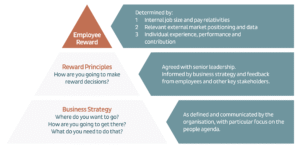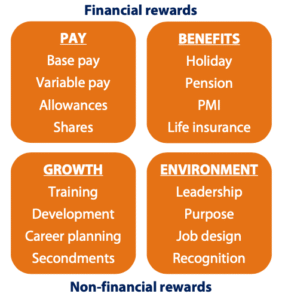
Principles of Reward
Reward principles are the fundamental values that guide how organisations design and implement rewards strategies. They ensure that pay, benefits, and recognition are delivered in ways that are fair, transparent, competitive, and motivating (CIPD, 2023). These principles are important because they shape employee perceptions of equity, influence orgnaisational culture and directly impact performance management. Research shows that organisations with reward systems built on clear principles have higher engagement, stronger trusts and lower turnover (Armstrong & Brown, 2019). For GreenFriendlyEco, adopting strong reward principles is critical to addressing high turnover, improving employee satisfaction, and shifting its organisational culture from negative to positive. Below is an evaluation of key reward principles and the potential impacts they may have on GreenFriendlyEco’s culture and performance.
Transparency
Transparency in reward systems, which involves open communication about pay structures, reward processes, and recognition criteria (ACAS, 2022), is a key factor in fostering employee engagement and satisfaction at GreenFriendlyEco. This open communication is crucial as it promotes trust and understanding among employees. It is closely linked to clear performance evaluation criteria, ensuring that clear, consistent, and achievable goals are set. This, in turn, provides GreenFriendlyEco employees with a clear understanding of the reward system, enhancing their appreciation of the organisation-wide pay procedures and their value within the company. For instance, a lack of transparent pension scheme information directed at senior staff at GreenFriendlyEco could lead to discontent among employees who may feel sidelined.
Impact on Culture and Performance
Through, involving employees in shaping incentive and benefit schemes, the company can rebuild trust and strengthen cultural alignment. For instance transparency at GreenFriendlyeco can involve employees and other stakeholders in making reward decisions on the types of incentives, benefits and recognition that would fit them best while staying in line with the business strategy. This will see GreenFriendlyEco successfully reverse the negative culture that is cropping in, as transparency in reward systems will build trust and fairness, reducing perceptions of favouritism. Take the example of ScottishPower Renewables which published its gender pay gap report in 2022 thus introducing a transparent pay framework to help build fairness and inclusivity, which improved trust among employees (ScottishPower, 2022).
When it comes to performance, employees who understand how rewards are linked to contribution are more likely to align behaviour with organisational goals. This will in turn see an improvement in both individual and organisational performance. It is however important to note that if not handled carefully, full pay transparency can sometimes generate resentment where unexplained pay gaps exist (Beck-Krala, 2020). GreenFriendlyEco should therefore be aware of instances where existing inequalities exposed through transparency could strike demotivation and seek to take corrective measures to prevent a performance nosedive.
Fairness and Consistency
Fairness and consistency are two principles that can help to boost the effectiveness of a reward strategy. They guarantee that reward decisions are applied uniformly across the workforce, ensuring employees perceive the system as just (CIPD, 2021). Organisational fairness entails balancing rewards to ensure employees are satisfied with the fairness of the compensation they receive from their counterparts within their workplace and other organisations (Sonboli et al., 2021). Consistency on the other hand implies that gradual and moderate implementation of rewards within the organisation to uphold integrity.
Impact on Culture and Performance
In molding culture, Fair and consistent rewards foster inclusivity, equality, and trust. Inconsistency erodes morale and can perpetuate perceptions of bias. This is especially vital in regards to the relationship and interaction between management and the employees as it impacts issues of trust and morale (Akpa et al., 2021). For instance, at GreenFrriendlyEco, the organisational perception of fairness might be threatened by the notion that they offer a particular pension scheme for selected staff. Borrowing a leaf from companies like EDF Energy UK which introduced a structured pay framework and internal equity reviews to ensure fairness, helping strengthen employee trust, can be one way for GreenFrriendlyEco to inject fairness into its reward strategy (EDF Energy, 2021). Equity in the reward system, can help decrease turnover and improve organisational culture as employees feel valued and treated equally.
Additionally, consistent rewards drive up engagement as employees believe that the reward systems are being administered relatively across the different organisational levels (Darwinbox, 2023). At GreenFriendlyEco, there is a clear need for the standard procedures and measurements for employee contibutions to be well coordinated and applied. This may be achieved by providing proper explanations on how employees can prioritise work and perform for them to be rewarded. Such consistency will also create a culture of reliability and predictability among the employees, enhancing their performance. Consistency in applying reward criteria will counteract negative perceptions of favouritism and reinforce a culture of fairness, supporting both retention and performance. It creates an environment where employees feel valued and want to surpass expectations by going above and beyond to ensure organisational success.
Total Reward Approach
The total reward approach integrates financial and non-financial rewards including pay, benefits, recognition, learning, and career opportunities, to provide a holistic employee experience (CIPD, 2024). This approach assumes that employees’ needs are satisfied through monetary incentives, tangible benefits, and other things such as promotions, bonuses, flexible working, and more giving the employee a whole experinece (Turnea & Prodan, 2020, CIPD, 2024).  Total reward links to motivational theories like Maslows’s and Vroom’s where it meets all employee’s needs thus achieving maximum motivation, commitment and engagement (Perkins & Jones, 2020).
Total reward links to motivational theories like Maslows’s and Vroom’s where it meets all employee’s needs thus achieving maximum motivation, commitment and engagement (Perkins & Jones, 2020).
Impact on Culture and Performance
Total reward fosters inclusivity by valuing different motivators (well-being, career growth, teamwork). GreenFriendlyEco is seeking to shift its culture and performance from negative to positive. With total rewards then the organisation can create positive work environments through well-being initiatives, develop a culture of team work through team-based rewards and continuous growth through training and career planning Turnea & Prodan, 2020).If GreenFriendlyEco succeeds in meeting the needs of heterogeneous employees, then the prospects of creating job satisfaction and reduced turnover rates will be achieved. For example, creating development opportunities or recognition programs will increase intrinsic motivation among the workers, hence boosting productivity and innovation. Ørsted, the global clean energy leader, offers sustainability-linked bonuses alongside career development opportunities, reinforcing a culture of innovation and commitment to shared environmental goals (Ørsted Annual Report, 2023). Furthermore, when all employee needs have been met then they are highly committed and motivated which in turn boost’s organisational performance. Meeting both intrinsic and extrinsic needs boosts commitment, discretionary effort, and retention (Perkins & Jones, 2020). This implies that when Incentive programs link employees to business targets, then the employees are able to make contributions that advance organisational success while strengthening workplace dedication.
Market Competitiveness and Job Evaluation
To attract and retain talent, the reward system has to be compatible with external market rates. Market competitiveness ensures pay is aligned with industry benchmarks, while job evaluation systematically assesses the relative worth of roles to support fairness (Marchington et al., 2020). When the reward decisions align with standard market rates, then they are perceived as fair and are likely to boost retention.
Impact on Culture and Performance
Fair, competitive pay promotes trust and loyalty. GreenFriendlyEco could be experiencing high exits as employees do not feel fairly remunerated compared to their counterparts in other organisations in the same industry, thus leaving to seek out better opportunities. Through job evaluations and industry benchmarks, GreenFriendlyEco can offer competitive rewards to its employees, thereby enhancing retention. With less turnover, there are decreased work disruptions and higher productivity, which in turn boosts performance. National Grid UK uses job evaluation (Hay methodology) and external benchmarking to ensure pay equity across roles, helping maintain workforce stability (National Grid Careers, 2023). Lagging behind market rates can foster dissatisfaction and attrition. Furthermore, increased employee exits result in increased turnover costs, however poor benchmarking may also result in increased labour costs. Therefore, while benchmarking against UK clean energy firms and introducing job evaluation frameworks, GreenFriendlyEco must ensure that it does so effectively to ensure employees feel fairly rewarded, reducing turnover and boosting organisational performance.





